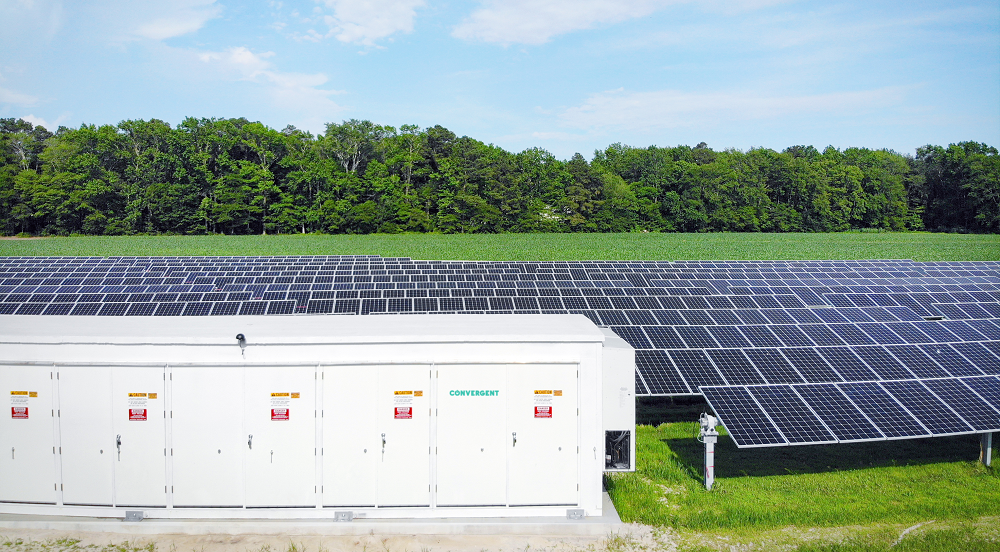Lowering Energy Costs and Carbon Emissions for the Chemical and Petrochemical Industries

In recent years, the chemical and petrochemical industries have faced mounting pressure to reduce carbon footprints and adopt sustainable practices. At the same time, energy prices are rising and becoming more volatile.
To address these concerns, many businesses have begun to turn to on-site renewable energy. On-site renewables lower operating costs and boost sustainability objectives at the same time. Further, they require no change to operations.
Energy storage systems allow electricity to be stored—and then discharged—at the most strategic times. Today, Lithium-ion batteries, the same batteries that are used in cell phones and electric vehicles, are the most commonly used type of energy storage. Like the batteries in your cell phone, commercial-, industrial-, and utility-scale battery energy storage systems can be charged with electricity from the grid, stored, and discharged when there is a deficit in supply or when energy is most expensive. Increasingly, battery energy storage is being paired with solar PV, which maximizes the value of solar energy to the grid (i.e., storing solar-generated electricity for when it is cloudy or after the sun sets).
In addition, deploying on-site battery solutions may also allow the early retirement of increasingly more difficult-to-operate diesel gen-sets.
Energy Usage and the Chemical and Petrochemical Industries

It is no secret that chemical and petrochemical manufacturing is highly energy-intensive. According to the Office of Energy Efficiency & Renewable Energy, chemical and petrochemical industries are responsible for approximately 40% of all industrial energy use and emissions in the United States.1 Manufacturing more broadly is the dominant contributor to annual industrial energy consumption and accounts for the largest share: approximately 76% in 2023.2
The Manufacturing Energy Consumption Survey recently reported that chemical manufacturing is one of six energy-intensive subsectors (along with petroleum and coal products, paper, primary metals, food, and nonmetallic minerals) that, combined, make up about 87% of total manufacturing energy consumption.
These statistics underscore the pivotal role of the chemical and petrochemical industries in shaping the energy landscape and the particular opportunity for your business to reduce both costs and carbon emissions. Embracing renewable energy solutions is not only a way to contribute to the clean energy future, it can contribute to your corporate goals and bottom line.
How Battery Storage or Solar-Plus-Storage Can Boost Your Bottom Line
As recently as five years ago, energy storage, most often in the form of a battery energy storage system, was not on the radar of most businesses as a way to manage energy costs. Today, however, battery storage, often paired with solar generation (solar-plus-storage), offers companies a proven way to reduce energy costs and reach sustainability goals at the same time.
If your business is considering a battery storage or solar-plus-storage solution to lower your energy bill, you are in good company. Businesses like Shell and Ford have done just that with a development partner (spoiler alert: that partner is Convergent Energy and Power).
Convergent, a leading developer of energy storage solutions in North America, has been in the energy storage and solar-plus-storage industry since its infancy, more than a decade ago. Throughout that time, we’ve worked closely with businesses to take the hassle out of energy storage by building, owning, and operating systems on their behalf. With battery storage, we’ve lowered our customers’ energy bills up to 40%.
However much you spend on energy each month, battery storage can unlock the next generation of cost savings and benefits. Battery storage systems are charged and discharged with electricity from the grid, allowing businesses to store energy when it is cheapest.
Battery storage or solar-plus-storage (if you have space for solar PV) is an increasingly popular solution to combat volatile energy prices, which the chemical and petrochemical industries are highly exposed to. These systems can help you lock in a lower energy price now, hedging against future energy price fluctuations and increases. The more you spend on your energy bill, the more you can save.

How Energy Storage and Solar-Plus-Storage Can Boost Sustainability Performance
Batteries do not reduce overall energy consumption but, rather, reduce energy consumption from the grid during the most strategic times.
Electricity is most expensive and carbon-intensive when it is most in demand because the grid must be prepared for maximum demand (if demand for electricity is greater than supply, that can lead to interruptions in power quality).
Energy storage is critical to a more flexible and resilient grid because it allows electrons to be stored during times of least demand and dispatched during times of greatest demand, which are also the most carbon-intensive. The reason the grid peaks are the most carbon-intensive is because the most prevalent way to meet demand is with coal peaker plants. The more storage we have on the grid, the lower the grid peaks, and the less power we’ll need overall.
Energy storage truly is the linchpin of the clean energy transition. Again, the more renewable energy on the grid, the better—but these resources only produce power when the sun is shining, or the wind is blowing. Energy storage can “firm up” renewable resources, maximizing their value to the grid–and to you.
As more industries and individual companies face pressure to demonstrate a commitment to mitigating the climate crisis, on-site renewables offer a CapEx-free solution. Energy storage and solar-plus-storage can contribute to your business’ environmental, social, and governance (ESG) or sustainability targets.
Conclusion: Reducing Energy Costs and Carbon Emissions with Battery Storage
The large amount of power used by chemical and petrochemical manufacturing facilities drastically exposes the sector to fluctuations in energy prices and increasing environmental regulations. On-site renewables can play a strategic role in plans to mitigate the impact of rising energy costs and hedge against future fluctuations. Further, on-site renewable generation is critical to getting ahead of and meeting increasing sustainability goals.
The benefit of battery storage and solar-plus-storage is that it provides classic dual benefits: you can save on costs and show the world your commitment to sustainability.
Battery storage systems are an ideal technology to deliver significant cost savings to your facility through peak demand savings, energy arbitrage, and other potential territory-based value stacks. When combined with solar photovoltaics, storage enhances the value of solar by energy shifting – charging during low-cost periods and discharging during higher-cost periods.
Our tagline is “Powered by Results.” We have delivered millions in savings to our industrial customers while enabling them to access cleaner, more reliable power. This opportunity is a win for all involved.
The best part: there’s no capital required from your business. The shared-savings contract Convergent offers means we share in the upside and only make money if our customers do.
If you’re ready to lower energy costs without impacting operations—and do it sustainably—schedule a free, no-obligation introductory call with our team today.
References:


